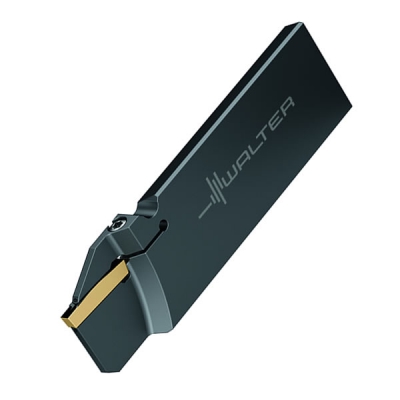
Walter has introduced the G1041, a new line of parting blades with a reinforced shank that ensures maximum stability and reliable grooving processes. Suitable for grooving and parting off on all kinds of turning machines, the G1041 features coolant supply through the clamping block, enabling precision coolant delivery directly to the chipbreaker and insert flank. This, together with PVD AL2O3 coating on the inserts, provides superior chip control and tool life and heightened process reliability, according to the company.
Secure Torx Plus screw clamping ensures simple and fast insert change, boosting flexibility and reducing costs. The tool's long GX-style inserts, securely clamped in the pocket, enable superior flatness, enhance chip control, and produce high quality surface finishes. It also facilitates higher cutting parameters, saving production time. G1041 blade size is 1.02/1.25 in (26/32 mm). Parting off is up to 2.56 in. (65 mm) dia., and cutting width is 0.079 - 0.157 in. (2-4 mm) with grooving depths of 0.630-1.25 in. (16-32 mm). Blade shank heights of 1.25 in. (32 mm) and 1.02 in. (26 mm) are available, as are right and left hand tools and contra versions.
Prime application areas for the G1041 include bar feeder, turret machine and multispindle machine work; parting to center; cases where there is insufficient coolant for blade and workpiece; in long overhangs with vibration; and in cases of uncontrolled chip formation.
Contact Details
Related Glossary Terms
- chipbreaker
chipbreaker
Groove or other tool geometry that breaks chips into small fragments as they come off the workpiece. Designed to prevent chips from becoming so long that they are difficult to control, catch in turning parts and cause safety problems.
- coolant
coolant
Fluid that reduces temperature buildup at the tool/workpiece interface during machining. Normally takes the form of a liquid such as soluble or chemical mixtures (semisynthetic, synthetic) but can be pressurized air or other gas. Because of water’s ability to absorb great quantities of heat, it is widely used as a coolant and vehicle for various cutting compounds, with the water-to-compound ratio varying with the machining task. See cutting fluid; semisynthetic cutting fluid; soluble-oil cutting fluid; synthetic cutting fluid.
- grooving
grooving
Machining grooves and shallow channels. Example: grooving ball-bearing raceways. Typically performed by tools that are capable of light cuts at high feed rates. Imparts high-quality finish.
- parting
parting
When used in lathe or screw-machine operations, this process separates a completed part from chuck-held or collet-fed stock by means of a very narrow, flat-end cutting, or parting, tool.
- physical vapor deposition ( PVD)
physical vapor deposition ( PVD)
Tool-coating process performed at low temperature (500° C), compared to chemical vapor deposition (1,000° C). Employs electric field to generate necessary heat for depositing coating on a tool’s surface. See CVD, chemical vapor deposition.
- shank
shank
Main body of a tool; the portion of a drill or similar end-held tool that fits into a collet, chuck or similar mounting device.
- turning
turning
Workpiece is held in a chuck, mounted on a face plate or secured between centers and rotated while a cutting tool, normally a single-point tool, is fed into it along its periphery or across its end or face. Takes the form of straight turning (cutting along the periphery of the workpiece); taper turning (creating a taper); step turning (turning different-size diameters on the same work); chamfering (beveling an edge or shoulder); facing (cutting on an end); turning threads (usually external but can be internal); roughing (high-volume metal removal); and finishing (final light cuts). Performed on lathes, turning centers, chucking machines, automatic screw machines and similar machines.

